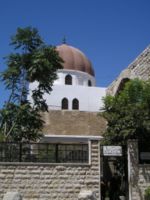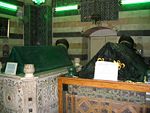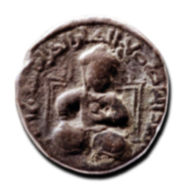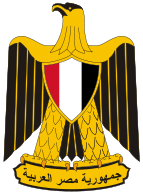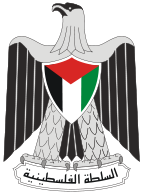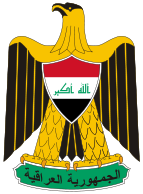Saladin
2008/9 Schools Wikipedia Selection. Related subjects: Historical figures
- Salah al-Din redirects here. For the governorate in Iraq, see Salah ad Din. For the Saladin (FV601) six-wheeled armoured car, see Alvis Saladin. For the animated series of Saladin, see Saladin: The Animated Series. For the Metal Gear character codenamed Saladin, see Big Boss.
| Ṣalāḥ ad-Dīn Yūsuf ibn Ayyūb | |
| Sultan of Egypt and Syria | |
 Artistic representation of Saladin |
|
| Reign | 1174–1193 |
|---|---|
| Coronation | 1174 |
| Full name | Ṣalāḥ ad-Dīn Yūsuf ibn Ayyūb |
| Born | c. 1137–1138 |
| Birthplace | Tikrit, Iraq |
| Died | March 4 1193 CE |
| Place of death | Damascus, Syria |
| Buried | Umayyad Mosque, Damascus, Syria |
| Predecessor | Nur ad-Din |
| Successor | Al-ˤAzīz ˤUthmān |
| Dynasty | Ayyubid |
| Father | Najm ad-Dīn Ayyūb |
Ṣalāḥ ad-Dīn Yūsuf ibn Ayyūb (Arabic: صلاح الدين يوسف ابن أيوب), known in English as Saladin, was a 12th century Kurd who became Sultan of Egypt and Syria, and a major Muslim political and military leader. At the height of his power, the Ayyubid dynasty, which he founded, ruled over Egypt, Syria, Iraq, The Hejaz and Yemen.
Ṣalāḥ ad-Dīn was born in the castle of Tikrit, Iraq in 532 AH (1137—1138 AD) and died just after dawn on 27 Safar 589 AH ( 4 March 1193 AD) in Damascus. He is best-known for uniting and also leading the Muslim armies during the Crusades and recapturing Jerusalem.
Early life
Yūsuf Ṣalāḥ ad-Dīn ibn Ayyūb was born in 1138 to a Kurdish family in Tikrit, Iraq. His father, Najm ad-Dīn Ayyūb, was banned from Tikrit and moved to Mosul where he met Imād ad-Din Zengi, the Turkish atabeg "governor" of Mosul and the founder of the Zengid dynasty, who was leading Muslim forces against the Crusaders in Edessa. Imād ad-Din Zengi appointed Najm ad-Din as the commander of his fortress in Baalbek. After the death of Imād ad-Din Zengi in 1146, his son, Nūr ad-Dīn Zengi, became atabeg of Mosul. Saladin received his name from Nūr ad-Dīn and was sent to Damascus to continue his education.
Muslim leader
Sultan of Egypt
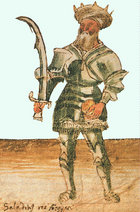
He received his initial military education from his uncle, Shirkuh, Nūr ad-Dīn's lieutenant who was representing him on campaigns against a faction of the Fatimid Caliphate of Egypt in the 1160s. Saladin eventually defeated the Fatimid faction and succeeded his uncle as vizier in 1169. There he inherited a difficult role defending Egypt against the incursions of the Crusader Kingdom of Jerusalem under Amalric I (see Crusader invasion of Egypt). His position was tenuous at first; he was not expected to last long in Egypt where there had been many changes of government in previous years due to a long line of child caliphs fought over by competing viziers. With a Sunni Syrian base, he had little control over the Egyptian army, which had been dominated by Shīˤas since the rise of the Fatimids and which was led in the name of the now otherwise powerless caliph al-Adid.
When the caliph died in September 1171, Saladin had the ˤulamā' pronounce the name of al-Mustadi, the Sunni - and, more importantly, Abbassid - caliph in Baghdad at sermon before Friday prayers; by their authority, they simply deposed the old line. Saladin ruled Egypt, but officially as the representative of the Turkish Seljuk ruler Nūr ad-Dīn, who himself conventionally recognized the Abbassid caliph.
Saladin revitalized the economy of Egypt, reorganized the military forces and, following his father's advice, stayed away from any conflicts with Nur ad-Din, his formal lord, after he had become the real ruler of Egypt. He waited until Nūr ad-Dīn's death before starting serious military actions: at first against smaller Muslim states, then directing them against the Crusaders.
With Nūr ad-Dīn's death in 1174, Ṣalāḥ ad-Dīn assumed the title of sultan in Egypt, founding the Ayyubid dynasty and restoring Sunni Islam in Egypt. He extended his territory westwards in the Maghreb and when his uncle was sent up the Nile to pacify some resistance of the former Fatimid supporters, he continued on down the Red Sea to conquer Yemen.
Sultan of Syria
On two occasions, in 1170 and 1172, Saladin retreated from an invasion of the Kingdom of Jerusalem. These had been launched by Nūr ad-Dīn and Saladin hoped that the Crusader kingdom would remain intact, as a buffer state between Egypt and Syria, until Saladin could gain control of Syria as well. Nūr ad-Dīn and Saladin were headed towards open war on these counts when Nūr ad-Dīn died in 1174. Nūr ad-Dīn's heir, as-Salih Ismail al-Malik, was a mere boy in the hands of court eunuchs, and died in 1181.
Immediately after Nūr ad-Dīn's death, Saladin marched on Damascus and was welcomed into the city. He reinforced his legitimacy there in the time-honored way, by marrying Nūr ad-Dīn's widow Ismat ad-Din Khatun. Aleppo and Mosul, on the other hand, the two other largest cities that Nūr ad-Dīn had ruled, were never taken but Saladin managed to impose his influence and authority on them in 1176 and 1186 respectively. While he was occupied in besieging Aleppo, on May 22, 1176, the shadowy Ismaili assassin group, the Hashshashin, attempted to murder him. They made two attempts on his life, the second time coming close enough to inflict wounds.
While Saladin was consolidating his power in Syria, he usually left the Crusader kingdom alone, although he was generally victorious whenever he did meet the Crusaders in battle. One exception was the Battle of Montgisard on November 25, 1177. He was defeated by the combined forces of Baldwin IV of Jerusalem, Raynald of Chatillon and the Knights Templar. Only one tenth of his army made it back to Egypt.
Battles against Crusaders
Saladin spent the subsequent year recovering from his defeat and rebuilding his army, renewing his attacks in 1179 when he defeated the Crusaders at the Battle of Jacob's Ford . after which a truce was declared between Saladin and the Crusader States in 1180. However, Crusader counter-attacks provoked further responses by Saladin. Raynald of Chatillon, in particular, harassed Muslim trading and pilgrimage routes with a fleet on the Red Sea, a water route that Saladin needed to keep open. In response, Saladin built a fleet of 30 galleys to attack Beirut in 1182. Raynald threatened to attack the holy cities of Mecca and Medina. In retaliation, Saladin twice besieged Kerak, Raynald's fortress in Oultrejordain, in 1183 and 1184. Raynald responded by looting a caravan of pilgrims on the Hajj in 1185. According to the later thirteenth century Old French Continuation of William of Tyre, Raynald captured Saladin's sister in a raid on a caravan, although this claim is not attested in contemporary sources, Muslim or Frankish. In fact, Raynald had attacked a preceding caravan, and Saladin set guards to ensure the safety of his sister and her son, who came to no harm.
Following the failure of his Kerak sieges, Saladin temporarily turned his attention back to another long-term project and resumed attacks on the territory of ˤIzz ad-Dīn (Masˤūd ibn Mawdūd ibn Zangi), around Mosul, which he had begun with some success in 1182. However, since then, Masˤūd had allied himself with the powerful governor of Azerbaijan and Jibal, who in 1185 began moving his troops across the Zagros Mountains, causing Saladin to hesitate in his attacks. The defenders of Mosul, when they became aware that help was on the way, increased their efforts, and Saladin subsequently fell ill, so in March 1186 a peace treaty was signed.
In July 1187, Saladin captured most of the Kingdom of Jerusalem. On July 4, 1187, he faced at the Battle of Hattin the combined forces Guy of Lusignan, King Consort of Jerusalem and Raymond III of Tripoli. In this battle alone the Crusader army was largely annihilated by the motivated army of Saladin in what was a major disaster for the Crusaders and a turning point in the history of the Crusades. Saladin captured Raynald de Chatillon and was personally responsible for his execution in retaliation for previously attacking Muslim pilgrim caravans. Guy of Lusignan was also captured but his life was spared.
That night, "with uncharacteristic coldbloodedness", Saladin ordered the execution of the "hundred or so" Templar and Hospitaller knights among the prisoners. Because of their religious "devotion and rigorous training", they were the "most feared" of the Christian soldiers. Seated on a dais before his army, Saladin watched as "the band of scholars, sufis and ascetics... carried out the ceremonial killing".
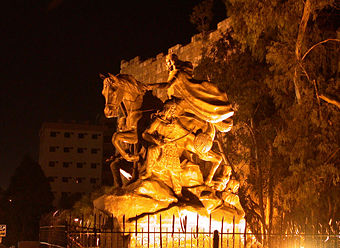
Capture of Jerusalem
Saladin had almost captured every Crusader city. Jerusalem capitulated to his forces on October 2, 1187 after a siege. Before the siege, Saladin had offered generous terms of surrender, which were rejected. After the siege had started, he was unwilling to promise terms of quarter to the European occupants of Jerusalem until Balian of Ibelin threatened to kill every Muslim in the city, estimated between 3000 to 5000, and to destroy Islam’s holy shrines of the Dome of the Rock and the al-Aqsa Mosque if quarter was not given. Saladin consulted his council and these terms were accepted. Ransom was to be paid for each Frank in the city whether man, woman or child. Saladin allowed many to leave without having the required amount for ransom for others.
Tyre, on the coast of modern-day Lebanon was the last major Crusader city that was not captured by Muslim forces (strategically, it would have made more sense for Saladin to capture Tyre before Jerusalem--however, Saladin chose to pursue Jerusalem first because of the importance of the city to Islam). The city was now commanded by Conrad of Montferrat, who strengthened Tyre's defences and withstood two sieges by Saladin. In 1188, at Tortosa, Saladin released Guy of Lusignan and returned him to his wife, Queen Sibylla of Jerusalem. They went first to Tripoli, then to Antioch. In 1189, they sought to reclaim Tyre for their kingdom, but were refused admission by Conrad, who did not recognize Guy as king. Guy then set about besieging Acre.
Battles with Richard the Lionheart
Hattin and the fall of Jerusalem prompted the Third Crusade, financed in England by a special " Saladin tithe". Richard I of England led Guy's siege of Acre, conquered the city and executed 3000 Muslim prisoners including women and children. Saladin retaliated by killing all Franks captured from August 28 - September 10. Bahā' ad-Dīn writes, "Whilst we were there they brought two Franks to the Sultan (Saladin) who had been made prisoners by the advance guard. He had them beheaded on the spot."
The armies of Saladin engaged in combat with the rival armies of King Richard I of England at the Battle of Arsuf on September 7, 1191, at which Saladin was defeated. All attempts made by Richard the lionheart to retrieve Jerusalem Kingdom had failed however during this Saladin's relationship with Richard was one of chivalrous mutual respect as well as military rivalry; both were celebrated in courtly romances. When Richard became ill with fever, Saladin offered the services of his personal physician. Saladin also sent him fresh fruit with snow, to chill the drink, as treatment. At Arsuf, when Richard lost his horse, Saladin sent him two replacements. Richard had suggested to Saladin that his sister could marry Saladin's brother - and Jerusalem could be their wedding gift. However, the two never met face to face; communication between the two was either written or by messenger.
The two came to an agreement over Jerusalem in the Treaty of Ramla in 1192, whereby the city would remain in Muslim hands but would be open to Christian pilgrimages; the treaty reduced the Latin Kingdom to a strip along the coast from Tyre to Jaffa. This treaty was supposed to last 3 years. Muslims and Christians now were living in harmony in the Holy Land, the place which matters in both religions.
Death
Saladin died on March 4, 1193, at Damascus, not long after Richard's departure. When they opened Saladin's treasury they found there was not enough money to pay for his funeral; he had given most of his money away in charity.
Saladin is buried in a mausoleum in the garden outside the Umayyad Mosque in Damascus, Syria. Emperor Wilhelm II of Germany donated a new marble sarcophagus to the mausoleum. Saladin was, however, not placed in it. Instead the mausoleum, which is open to visitors, now has two sarcophagi: one empty in marble and one in wood containing the body of Saladin.
Recognition
Despite his fierce struggle against the crusades, Saladin achieved a great reputation in Europe as a chivalrous knight, so much so that there existed by the fourteenth century an epic poem about his exploits, and Dante included him among the virtuous pagan souls in Limbo. Saladin appears in a sympathetic light in Sir Walter Scott's The Talisman (1825). Despite the Crusaders' slaughter when they originally conquered Jerusalem in 1099, Saladin granted amnesty and free passage to all common Catholics and even to the defeated Christian army, as long as they were able to pay the aforementioned ransom (the Greek Orthodox Christians were treated even better, because they often opposed the western Crusaders). An interesting view of Saladin and the world in which he lived is provided by Tariq Ali's novel The Book of Saladin.
Notwithstanding the differences in beliefs, the muslim Saladin was respected by Christian lords, Richard especially. Richard once praised Saladin as a great prince, saying that he was without doubt the greatest and most powerful leader in the Islamic world. Saladin in turn stated that there was not a more honorable Christian lord than Richard. After the treaty, Saladin and Richard sent each other many gifts as tokens of respect, but never met face to face.
In April 1191, a Frankish woman's three month old baby had been stolen from her camp and had been sold on the market. The Franks urged her to approach Saladin herself with her grievance. After Saladin used his own money to buy the child, "he gave it to the mother and she took it; with tears streaming down her face, and hugged it to her breast. The people were watching her and weeping and I (Ibn Shaddad) was standing amongst them. She suckled it for some time and then Saladin ordered a horse to be fetched for her and she went back to camp."
The name Ṣalāḥ ad-Dīn means "Righteousness of Faith," and through the ages Saladin has been an inspiration for Muslims in many respects. Modern Muslim rulers have sought to commemorate Saladin through various measures. A governorate centered around Tikrit and Samarra in modern-day Iraq, Salah ad Din Governorate, is named after him, as is Salahaddin University in Arbil. A suburb community of Arbil, Masif Salahaddin, is also named after him.
Few structures associated with Saladin survive within modern cities. Saladin first fortified the Citadel of Cairo (1175 - 1183), which had been a domed pleasure pavilion with a fine view in more peaceful times. In Syria, even the smallest city is centred on a defensible citadel, and Saladin introduced this essential feature to Egypt.
Among the forts he built was Qalaat al-Gindi, a mountaintop fortress and caravanserai in the Sinai. The fortress overlooks a large wadi which was the convergence of several caravan routes that linked Egypt and the Middle East. Inside the structure are a number of large vaulted rooms hewn out of rock, including the remains of shops and a water cistern. A notable archaeological site, it was investigated in 1909 by a French team under Jules Barthoux.
According to the French writer René Grousset,
"It is equally true that his generosity, his piety, devoid of fanaticism, that flower of liberality and courtesy which had been the model of our old chroniclers, won him no less popularity in Frankish Syria than in the lands of Islam".
When German Kaiser Wilhelm the Second went to Syria he laid a wreath at the tomb of Saladin in Damascus with the inscription,
"A Knight without fear or blame who often had to teach his opponents the right way to practice chivalry".
Legacy
Although the Ayyubid dynasty he founded would only outlive him by fifty-seven years, the legacy of Saladin within the Arab World continues to this day. With the rise of Arab nationalism in the Twentieth Century, particularly with regard to the Arab-Israeli conflict, Saladin's heroism and leadership gained a new significance. Saladin's liberation of Palestine from the European Crusaders was taken as the inspiration for the modern-day Arabs' struggle against Zionism. Moreover, the glory and comparative unity of the Arab World under Saladin was seen as the perfect symbol for the new unity sought by Arab nationalists, such as Gamal Abdel Nasser. For this reason, the Eagle of Saladin became the symbol of revolutionary Egypt, and was subsequently adopted by several other Arab states ( Iraq, Palestine, and Yemen).
Saladin in film
In 1963 an Egyptian movie about Saladin was released, titled Al Nasser Salah Ad-Din. In the 1965 Doctor Who serial The Crusade he was played by Bernard Kay. 2005's Kingdom of Heaven, directed by Ridley Scott, has Saladin portrayed by Syrian actor Ghassan Massoud. In the 2007 Swedish film Arn – The Knight Templar (Arn – Tempelriddaren), Saladin is portrayed by British-Indian actor and supermodel Milind Soman.
